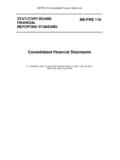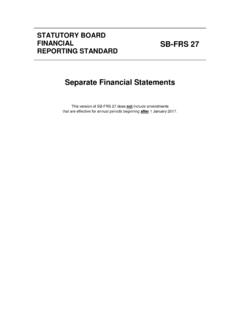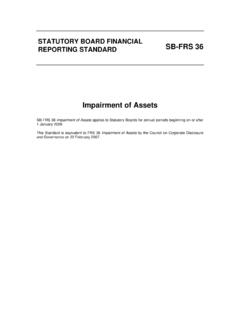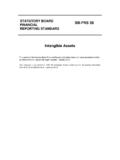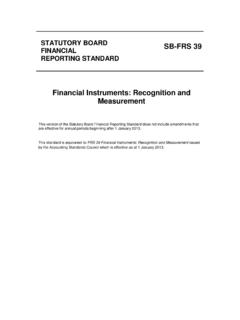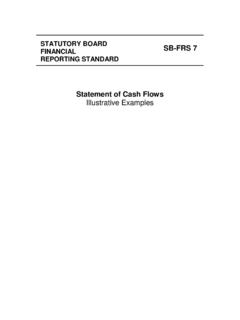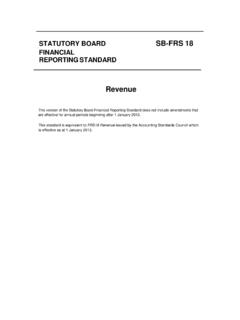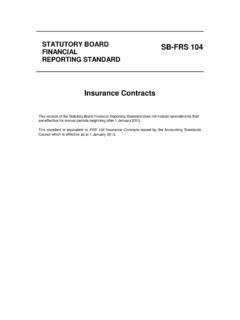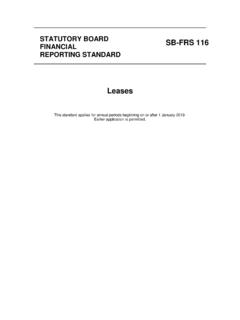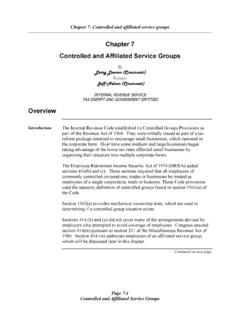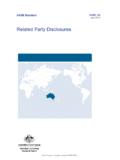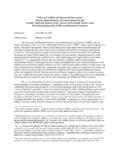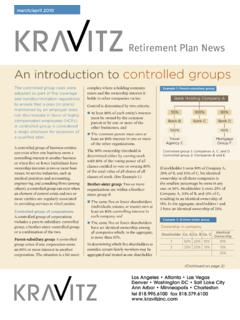Transcription of Related Party Disclosures - assb.gov.sg
1 STATUTORY BOARD. FINANCIAL SB-FRS 24. REPORTING STANDARD. Related Party Disclosures This version of the Statutory Board Financial Reporting Standard does not include amendments that are effective for annual periods beginning after 1 January 2013. SB-FRS 24. CONTENTS. Paragraphs OBJECTIVE 1. SCOPE 2. PURPOSE OF Related Party Disclosures 5. DEFINITIONS 9. Disclosures 13. All entities 13. Government- Related entities 25. EFFECTIVE DATE AND TRANSITION 28. 2. SB-FRS 24. Statutory Boards Financial Reporting Standard 24 Related Party Disclosures (SB-FRS 24) is set out in paragraphs 1 29 and the Appendix. All of the paragraphs have equal authority. S B- FRS. 24 should be read in the context of its objective, the Preface to Statutory Boards Financial Reporting Standards and the Conceptual Framework for Financial Reporting.
2 SB-FRS 8. Accounting Policies, Changes in Accounting Estimates and Errors provides a basis for selecting and applying accounting policies in the absence of explicit guidance. The revised Standard was issued in January 2011. 3. SB-FRS 24. Statutory Board Financial Reporting Standard 24. Related Party Disclosures Objective 1 The objective of this Standard is to ensure that an entity's financial statements contain the Disclosures necessary to draw attention to the possibility that its financial position and profit or loss may have been affected by the existence of Related parties and by transactions and outstanding balances, including commitments, with such parties. Scope 2 This Standard shall be applied in: (a) identifying Related Party relationships and transactions;. (b) identifying outstanding balances, including commitments, between an entity and its Related parties.
3 (c) identifying the circumstances in which disclosure of the items in (a) and (b) is required; and (d) determining the Disclosures to be made about those items. 3 This Standard requires disclosure of Related Party relationships, transactions and outstanding balances, including commitments, in the consolidated and separate financial statements of a parent, venturer or investors presented in accordance with SB-FRS 27 Consolidated and Separate Financial Statements. This Standard also applies to individual financial statements. 4 Related Party transactions and outstanding balances with other entities in a group are disclosed in an entity's financial statements. Intragroup Related Party transactions and outstanding balances are eliminated in the preparation of consolidated financial statements of the group.
4 Purpose of Related Party Disclosures 5 Related Party relationships are a normal feature of commerce and business. For example, entities frequently carry on parts of their activities through subsidiaries, joint ventures and associates. In those circumstances, the entity has the ability to affect the financial and operating policies of the investee through the presence of control, joint control or significant influence. 6 A Related Party relationship could have an effect on the profit or loss and financial position of an entity. Related parties may enter into transactions that unrelated parties would not. For example, an entity that sells goods to its parent at cost might not sell on those terms to another customer. Also, transactions between Related parties may not be made at the same amounts as between unrelated parties.
5 7 The profit or loss and financial position of an entity may be affected by a Related Party relationship even if Related Party transactions do not occur. The mere existence of the relationship may be sufficient to affect the transactions of the entity with other parties. For example, a subsidiary may terminate relations with a trading partner on acquisition by the parent of a fellow subsidiary engaged in the same activity as the former trading partner. Alternatively, one Party may refrain from acting because of the significant influence of 4. SB-FRS 24. another for example, a subsidiary may be instructed by its parent not to engage in research and development. 8 For these reasons, knowledge of an entity's transactions, outstanding balances, including commitments, and relationships with Related parties may affect assessments of its operations by users of financial statements, including assessments of the risks and opportunities facing the entity.
6 Definitions 9 The following terms are used in this Standard with the meanings specified: A Related Party is a person or entity that is Related to the entity that is preparing its financial statements (in this Standard referred to as the reporting entity'). (a) A person or a close member of that person's family is Related to a reporting entity if that person: (i) has control or joint control over the reporting entity;. (ii) has significant influence over the reporting entity; or (iii) is a member of the key management personnel of the reporting entity or of a parent of the reporting entity. (b) An entity is Related to a reporting entity if any of the following conditions applies: (i) The entity and the reporting entity are members of the same group (which means that each parent, subsidiary and fellow subsidiary is Related to the others).
7 (ii) One entity is an associate or joint venture of the other entity (or an associate or joint venture of a member of a group of which the other entity is a member). (iii) Both entities are joint ventures of the same third Party . (iv) One entity is a joint venture of a third entity and the other entity is an associate of the third entity. (v) The entity is a post-employment benefit plan for the benefit of employees of either the reporting entity or an entity Related to the reporting entity. If the reporting entity is itself such a plan, the sponsoring employers are also Related to the reporting entity. (vi) The entity is controlled or jointly controlled by a person identified in (a). (vii) A person identified in (a)(i) has significant influence over the entity or is a member of the key management personnel of the entity (or of a parent of the entity).
8 A Related Party transaction is a transfer of resources, services or obligations between a reporting entity and a Related Party , regardless of whether a price is charged. 5. SB-FRS 24. Close members of the family of a person are those family members who may be expected to influence, or be influenced by, that person in their dealings with the entity and include: (a) that person's children and spouse or domestic partner;. (b) children of that person's spouse or domestic partner; and (c) dependants of that person or that person's spouse or domestic partner. Compensation includes all employee benefits (as defined in FRS 19 Employee Benefits) including employee benefits to which FRS 102 Share-based Payment applies. Employee benefits are all forms of consideration paid, payable or provided by the entity, or on behalf of the entity, in exchange for services rendered to the entity.
9 It also includes such consideration paid on behalf of a parent of the entity in respect of the entity. Compensation includes: (a) short-term employee benefits, such as wages, salaries and social security contributions, paid annual leave and paid sick leave, profit-sharing and bonuses (if payable within twelve months of the end of the period) and non-monetary benefits (such as medical care, housing, cars and free or subsidised goods or services) for current employees;. (b) post-employment benefits such as pensions, other retirement benefits, post- employment life insurance and post-employment medical care;. (c) other long-term employee benefits, including long-service leave or sabbatical leave, jubilee or other long-service benefits, long-term disability benefits and, if they are not payable wholly within twelve months after the end of the period, profit-sharing, bonuses and deferred compensation.
10 (d) termination benefits; and (e) share-based payment. Control is the power to govern the financial and operating policies of an entity so as to obtain benefits from its activities. Joint control is the contractually agreed sharing of control over an economic activity. Key management personnel are those persons having authority and responsibility for planning, directing and controlling the activities of the entity, directly or indirectly, including any director (whether executive or otherwise) of that entity. Significant influence is the power to participate in the financial and operating policy decisions of an entity, but is not control over those policies. Significant influence may be gained by share ownership, statue or agreement. Government refers to government, government agencies and similar bodies whether local, national or international.
